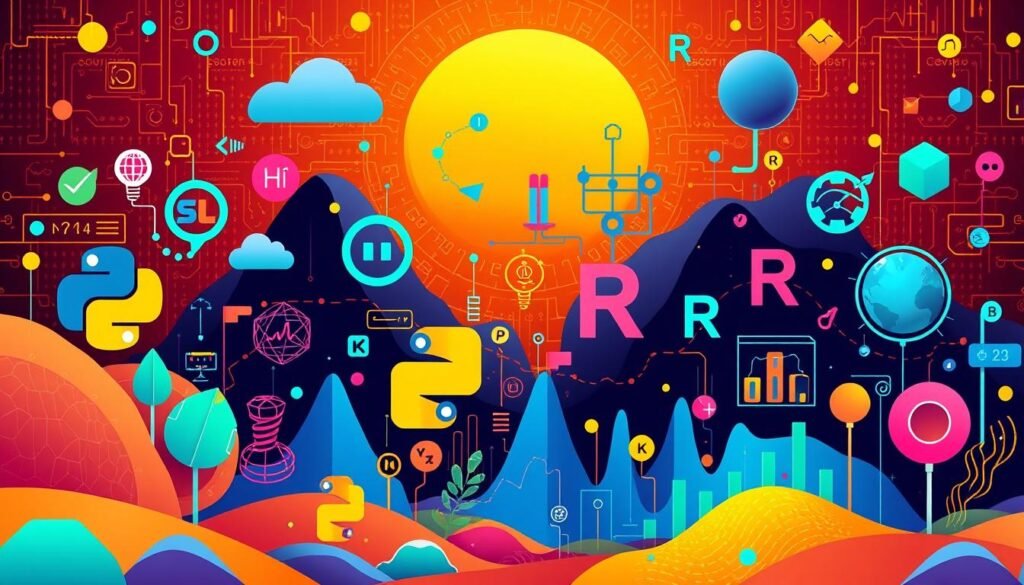Data science career opportunities are expanding rapidly, with demand for data science skills expected to grow by 27.9% by 2026. Today, a data science career is transforming industries by helping organizations make smarter, data-driven decisions.
It combines statistics, machine learning, and big data to uncover valuable insights. By mastering these skills, you can launch a rewarding career in analytics—ideal for those who enjoy spotting patterns, predicting trends, and turning data into action.
Key Takeaways:
- Data science is a rapidly growing field with high demand for skilled professionals
- Mastering data science skills can lead to a successful analytics career
- Data science combines statistical analysis, machine learning, and big data technologies
- Data-driven insights are transforming industries and driving business decisions
- A strong foundation in mathematics and programming is essential for data science success
In this article, we’ll cover the basics of data science and the skills you need. We’ll also look at where you can use your skills. Get ready for a career-changing journey that puts you at the heart of the data revolution.
Understanding the Fundamentals of Data Science:
Data science is a field that combines statistics, mathematics, computer science, and domain expertise. To do well in data science, you need to know the basics and understand the data science process. Let’s explore the key concepts of data science fundamentals.

Key Concepts and Terminology:
Data science has several key concepts that are its foundation. Some important terms include:
- Data mining: Finding patterns and insights in large datasets.
- Machine learning: Algorithms that let computers learn from data without being programmed.
- Statistical analysis: Methods for analyzing and interpreting data, making conclusions, and predictions.
- Big data: Datasets too large and complex for traditional tools.
The Data Science Process:
The data science process is a structured way to solve problems and find insights in data. It includes the following steps:
- Data collection and preparation
- Exploratory data analysis
- Data modeling and algorithm selection
- Model training and evaluation
- Deployment and monitoring
By following this process, data scientists can solve complex problems and deliver impactful solutions.
Tools and Technologies Used in Data Science:
Data science uses many tools and technologies to work with data. Some common tools include:
| Tool | Description |
|---|---|
| Python | A versatile programming language used for data analysis, machine learning, and data visualization. |
| R | A statistical programming language popular for its extensive libraries and packages. |
| SQL | A query language for managing and manipulating relational databases. |
| Tableau | A powerful data visualization tool for creating interactive dashboards and reports. |
New tools and frameworks keep coming, helping data scientists tackle more complex challenges. Keeping up with the latest advancements is key to success in the field.
“Data science is about extracting insights from data and using them to make better decisions. It’s a powerful tool that can transform businesses and solve real-world problems.”
Developing Essential Skills for Data Science Career:
To excel in data science, you need a strong foundation in key skills. These include programming languages, statistical analysis, probability and machine learning algorithms. Mastering these areas helps data scientists solve complex data problems and find valuable insights.
Programming Languages: Python and R:
Python and R are top choices for data science. Python is simple, versatile, and has many libraries for data work. R is great for stats and has lots of packages for visualizing and Modelling data. Knowing these languages well is key for working with big data.

Statistical Analysis and Probability:
Understanding stats and probability is crucial for data scientists. Stats helps explore, summarize, and interpret data. Probability is key for making decisions and predictions. Data scientists need to know about descriptive stats, hypothesis testing and probability distributions to make sense of data.
Machine Learning Algorithms:
Machine learning is central to data science. These algorithms let computers learn from data and make predictions. Some common ones are:
| Algorithm | Description |
|---|---|
| Linear Regression | Predicts a continuous output based on input features |
| Logistic Regression | Classifies data into binary categories |
| Decision Trees | Builds tree-like models for classification or regression |
| Random Forests | Ensemble method combining multiple decision trees |
| Support Vector Machines | Finds optimal hyperplanes for classification or regression |
The goal is to turn data into information, and information into insight.
By mastering these skills, data scientists can fully utilize data. This leads to meaningful insights for businesses and organizations.
Exploring Different Domains of Data Science:
Data science is now key in many industries, changing how businesses work and decide. It’s used in healthcare, finance, e-commerce, and entertainment, among others. Let’s look at some areas where data science is making a big difference.
In healthcare, data science helps improve patient care and makes medical work smoother. It analyzes patient records, medical images, and genetic data. This helps doctors make better diagnoses and create treatment plans tailored to each patient. For instance, it helps spot diseases like cancer early by looking at medical images.
In finance, data science is crucial for spotting fraud, assessing risk, and improving investments. Banks and other financial institutions use it to understand financial data. This helps them make smart choices and avoid risks.
E-commerce has also been changed by data science. Online stores use it to make shopping better for customers, suggest products, and set prices. By studying what customers buy and how they browse, data scientists help e-commerce sites meet customer needs and keep them coming back.
“Data science is not just about analyzing data; it’s about uncovering insights that drive meaningful change and innovation across industries.”
Other areas where data science is making a big impact include:
- Transportation and logistics
- Energy and utilities
- Manufacturing and supply chain management
- Telecommunications
- Media and entertainment
As data gets bigger and more complex, the need for data scientists will grow. Knowing how data science is used in different fields helps professionals find the right fit for their skills and interests.
Building a Strong Foundation in Mathematics and Statistics:
To do well in data science, you need a solid base in math and stats. These subjects are key for data analysis, machine learning, and predictive modeling. Learning about linear algebra, calculus, probability theory, and regression analysis is crucial. It lets data scientists get the most out of their data insights.
Linear Algebra and Calculus:
Linear algebra and calculus are vital in data science. It works with vectors, matrices and transformations. It helps with handling high-dimensional data. Calculus, meanwhile, is for analyzing changes, optimizing functions and modeling complex relationships.
Probability Theory and Distributions:
Probability theory studies random events and their chances. It helps quantify uncertainty and make decisions with data. In data science, probability distributions model variable behavior and predict outcomes. Some common distributions include:
| Distribution | Description |
|---|---|
| Normal (Gaussian) | Symmetric bell-shaped curve, used for continuous data |
| Binomial | Models the number of successes in a fixed number of trials |
| Poisson | Models the number of events occurring in a fixed interval |
| Exponential | Models the time between events in a Poisson process |
Hypothesis Testing and Regression Analysis:
Hypothesis testing makes decisions with data. It involves setting up hypotheses, collecting data, and using probability to decide. Regression analysis models the relationship between variables. It helps predict how changes in variables affect outcomes.
“The goal is to turn data into information, and information into insight.” – Carly Fiorina, former CEO of Hewlett-Packard
With a strong math and stats foundation, data scientists can fully utilize their insights. This makes a big difference in their field.
Mastering Machine Learning Techniques:
To excel in data science, mastering various machine learning techniques is key. These techniques help data scientists build predictive models and find valuable insights in complex data. Let’s look at the main areas of machine learning that aspiring data scientists should focus on.
Supervised learning is a basic technique where algorithms learn from labeled data. They train on datasets with known outcomes. This way, they can predict future outcomes from new data. Some popular supervised learning algorithms include:
- Linear Regression
- Logistic Regression
- Decision Trees
- Random Forests
- Support Vector Machines (SVM)
Unsupervised learning, on the other hand, finds patterns in unlabeled data. It helps discover hidden relationships and groupings. Common unsupervised learning techniques include:
- K-means Clustering
- Hierarchical Clustering
- Principal Component Analysis (PCA)
- t-SNE (t-Distributed Stochastic Neighbor Embedding)
Data scientists also need to master feature engineering. This involves selecting and transforming the most relevant features. This improves model performance. Key aspects of feature engineering include:
| Technique | Description |
|---|---|
| Feature Selection | Identifying the most informative features for the model |
| Feature Scaling | Normalizing or standardizing features to a common scale |
| Feature Extraction | Creating new features from existing ones to capture higher-level patterns |
| Dimensionality Reduction | Reducing the number of features while preserving important information |
“Machine learning is a field of study that gives computers the ability to learn without being explicitly programmed.” – Arthur Samuel
Model selection and evaluation are also crucial. Data scientists must choose the right algorithm and evaluate its performance. Metrics like accuracy and F1-score are used for this. Cross-validation helps assess the model’s ability to generalize and prevent overfitting.
By mastering these techniques, data scientists can unlock their data’s full potential. They can build powerful predictive models that drive business value and innovation.
Diving into Deep Learning and Neural Networks:
Deep learning has changed data science, making machines learn like humans. At its heart are neural networks, which can handle complex data. Let’s dive into the exciting world of deep learning and neural networks.
Understanding Neural Network Architectures:
Neural networks have layers of nodes, or neurons, that work together. The input layer gets the data, which then goes through hidden layers. Here, the real work happens.
Each neuron uses weights and biases to process the data. It then sends the result to the next layer. The final layer makes the network’s predictions.
Neural networks learn from data. They adjust their settings through backpropagation. This process makes them better over time.
Convolutional Neural Networks (CNNs) for Image Analysis:
CNNs have revolutionized image analysis. They use convolutional and pooling layers to work with visual data. The convolutional layers find patterns, while pooling layers reduce dimensions.
CNNs excel in tasks like object detection and facial recognition. They can automatically learn from images, making image classification and segmentation efficient.
Recurrent Neural Networks (RNNs) for Sequential Data:
RNNs handle sequential data like time series and text. They have loops that let information flow back, capturing temporal dependencies. This makes them great for tasks like language translation.
RNNs are also good at speech recognition. They can process and generate sequences, making them perfect for sequential data.
| Neural Network | Application | Key Features |
|---|---|---|
| Convolutional Neural Networks (CNNs) | Image Analysis | Convolutional and pooling layers, feature extraction |
| Recurrent Neural Networks (RNNs) | Sequential Data | Recurrent connections, temporal dependencies |
Deep learning is not just about training a model, but also about understanding the problem and the data.
Deep learning and neural networks are changing data science. They help us solve complex problems. By using CNNs for images and RNNs for sequences, we unlock new insights.
Handling Big Data and Scalable Computing:
As data science projects grow, handling big data becomes a big challenge. Traditional methods often can’t handle massive datasets well. Data scientists use distributed computing and cloud platforms for scalable computing.
Distributed Computing with Hadoop and Spark:
Hadoop and Spark are key frameworks for big data. Hadoop is open-source and processes data across computer clusters. It has HDFS for storage and MapReduce for processing.
Spark is fast and general-purpose. It’s great for clusters and in-memory computing. This makes it faster than Hadoop for some tasks, like machine learning.
Using Hadoop and Spark, data scientists can handle big data well. These frameworks spread the work across nodes, speeding up analysis.
Cloud Computing Platforms for Data Science Career:
Cloud computing has changed data science with scalable infrastructure. AWS, GCP, and Azure offer services for data science.
Cloud platforms bring many benefits:
- Scalability: You can scale resources as needed.
- Cost-effectiveness: You only pay for what you use.
- Collaboration: Clouds make teamwork easier.
Cloud computing lets data scientists focus on analysis. They get reliable infrastructure from cloud platforms.
Conclusion:
In this article, we’ve looked into the world of data science and how to succeed in analytics. We’ve covered the basics, key skills and specialized areas like machine learning. The path of a data scientist is all about learning and growing.
To do well in data science, you need to be curious, flexible and eager to learn more. Take on real projects, work with different teams and help make decisions with data. This is key in many fields.
Starting your data science journey means you’ll always find new things to learn. Keep up with trends, and always explore what data science can do. This way, you’ll never stop growing.
With hard work, determination and a love for data, you can succeed in analytics. Begin your journey, dive into data and let your curiosity lead you to a rewarding career in data science.
FAQ:
What is data science and why is it important for an analytics career?
Data science combines statistics, machine learning, and domain knowledge to find insights in data. It’s key for analytics careers because companies use data to make better decisions and stay ahead.
What are the key concepts and terminology in data science?
Key data science concepts include data mining, statistical modeling, and machine learning. Knowing terms like features and algorithms helps in talking about data science.
What programming languages are commonly used in data science?
Python and R are top choices for data science. Python is versatile and easy to read, while R is great for stats and visuals. Knowing one is crucial for a data science job.
What are the different domains and applications of data science?
Data science is used in many fields like healthcare, finance, and e-commerce. In healthcare, it predicts diseases and tailors treatments. Finance uses it for fraud detection and risk assessment. E-commerce benefits from it for recommendations and understanding customer behavior.
How important is a strong foundation in mathematics and statistics for data science?
Knowing math and stats well is vital for data science. Concepts like linear algebra and probability are foundational. Understanding hypothesis testing and regression is also key for analyzing data.
What are the different types of machine learning techniques used in data science?
Machine learning includes supervised, unsupervised, and reinforcement learning. Supervised learning uses labeled data for predictions. Unsupervised learning finds patterns in data without labels. Reinforcement learning helps agents learn through interaction.
What is deep learning, and how is it different from traditional machine learning?
Deep learning uses artificial neural networks to learn data hierarchically. It’s different because it can automatically learn from raw data. This makes it great for tasks like image and speech recognition.
What are the challenges and solutions for handling big data in data science?
Big data is hard to store, process, and analyze because of its size and complexity. Data scientists use frameworks like Hadoop and Spark for parallel processing. Cloud platforms like AWS and GCP offer scalable solutions for big data.





















